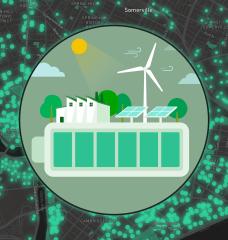
Global performance of green bond (GB) can be evaluated by using two different parameters:
- Financial performance: Financial performance denotes the financial return of a GB within a specific time period. Financial performance can be measured by using financial indicators and ratio, i.e. Net Present Value (NPV), Internal Rate of Return (IRR), Payback Period, etc. Financial performance can be used to compare the market return of a GB with other financial instruments. One of the key advantages of GB is it helps the investors to diversify their portfolio.
- Environmental, Social, and Governance (ESG) performance: ESG performance denotes the gross positive impacts achieved by investing on a GB. Positive impacts include increasing environmental sustainability, decreasing GHG and heat emission, safeguarding bio-diversity, controlling and preventing pollution, and improving climate governance. It is, however, difficult to transfer the ESG performance to quantitative financial value. Therefore, the overall performance of GB often remains underappreciated.
Based on the above parameters, the following sections provide an analytical overview of different countries in Asia.
Australia
The Australian bond market saw a significant investment of AUD600mn ($429.42mn) in 2014 which increased to AUD1200mn ($859mn) in 2015. 50% of the bonds were issued by international development banks, whereas the rest 50% were issued by domestic commercial banks. Recently in 2019, the Clean Energy Finance Corporation has invested more than $2bn in capital to support renewable energy projects in Australia. Foreign investment for the Australian GB market is also flourishing. In 2015, 28% of the total GB investment in Australia came from outside of the country (18% from Asia and the US, and 10% from Europe).
The Australian bond market largely centers on the application of renewable energy. The country is pacing up with the rising interest of the global market and the shift towards more renewable energy and green infrastructure projects. This is becoming more relevant for the investors to invest as the global GB market is becoming self-sustaining.
73% of the GB financing goes to the renewable energy sector, whereas 13% on green building, 4% on transport and 4% on energy efficiency.
Bangladesh
Although Bangladesh has not yet implemented any GB issuance in its domestic market, it has already adopted various green financing strategies on its own and has remained very vocal in international forums on climate risks and remedies. The Bangladesh Bank has formulated a modus operandi of green financing for banks and financial institutions, which financial institutions now follow.
Business communities and policymakers often identify a higher interest rate in Bangladesh as the main challenge for green financing. Commercial banks lend on green projects for a 9% interest rate which is higher than the expected. Bangladesh Bank has a BDT200crore ($23.68mn) revolving fund for financing green projects. That fund lends money for a 5% interest rate. The industry stakeholders consider that a 6-7% rate will help to proliferate the Green projects.
Bangladesh Bank can use its own fund to cross-subsidize the GB issuance. Another policy intervention can be to make GB offer as regulatory bindings for the commercial banks as a percentage of their total lending portfolio.
China
China’s GB market began to take shape in 2015 after the People’s Bank of China (PBoC) unveiled guidelines to incorporate the new asset class into the country’s financial system. The National Development & Reform Commission (NDRC) and China Securities Regulatory Commission (CSRC) have also released guidance on GB standards.
Despite being a relatively new entrant in the global GB market, China has already assumed a leading role. In a short period, Chinese regulators and authorities have introduced the new asset class, created a market for it and unveiled comprehensive guidelines on how to use, manage and report the proceeds. In 2016, China claimed 7 out of 10 of the year’s largest GBs and raised $33.7bn, which was more than one-third of the world’s total issuance. To date, China’s GB issuance exceeds that of any other country or supranational organization. Most recently, the world's largest carbon emitter issued around $37.1bn of GBs in 2017.
China has put a balanced emphasis on energy-related issues, transport, and pollution control. The country has emphasized the following sectors for GB proliferation:
- Clean energy (27%),
- Pollution prevention control (19%),
- Clean transport (16%),
- Ecological protection and climate change adaption (13%),
- Resource conversation and recycling (8%),
- Energy-saving (7%), and
- General use or refinancing (7%).
India
India is emerging as a significant GB market and was among the top issuers in the debut year (2015) itself. GB issuance in India was to the tune of $1.95bn in the September quarter of 2017, making it the fifth-largest issuer in terms of size in the world for the quarter. The proceeds of these bonds are allocated to renewable energy projects, low carbon transportation, energy efficiency projects, and green buildings.
To date, India has cumulatively issued $6.5bn worth of GBs, which is 41% higher than the issuance in 2017.
The Reserve Bank of India (RBI) has included the renewable energy sector as part of the priority sector. As a result, banks must dedicate a certain portion of their overall lending book towards the priority sector, which will, in turn, help credit flow in this sector. In 2017, renewable energy and energy efficiency contributed to 83.4% of the total GB issuance and 13.1% of the issuance went to the transport sector.
Renewable energy, which benefits from a clear policy thrust, is expected to see a stream of further issuance. Further growth potential is expected to be seen in the transport and building sectors. Green securitization is another avenue for market growth.
Indonesia
To counter the sustainability and development challenges, the Financial Services Authority (OJK) of Indonesia has issued a set of policies on sustainable financing to encourage low carbon economic growth.
The Indonesian Ministry of Finance, through its Climate Budget Tagging mechanism, has identified more than Rp78tr ($5,7bn) of FY 2017 national budget component related to climate change impacts, amounting to a 32% increase over the FY 2016 budget. Till 2018, the country had cumulatively issued $1.98bn worth of GB investment.
Indonesia actively participated in the GB market by issuing $1.25mn sovereign Green Sukuk in February 2018 to fund projects such as renewable energy, green tourism, and waste management.
Eligible green projects must fall into at least one of the following sectors:
- Renewable energy, and Energy efficiency (38%),
- Green buildings (16%),
- Adaptation (16%),
- Sustainable transport (8%),
- Land use (13%), and
- Water (8%).
Japan
Japan is one of the most successful countries in the world that has adopted and enabled GB mechanism in almost every sphere of its applications. To date, the Japanese government has issued GBs worth JPY147,600mn ($1,319mn) through its 17 corporations, government agencies and development banks. Additionally, GBs issued by Japanese companies, including those issued overseas, totaled $2.06bn dollars in 2017.
Japan through its Japan Exchange Group (JPX) has set up initiatives to support listed companies in adopting ESG practices. Similarly, the Ministry of Environment, Japan (MOEJ) set up Green Bond Guidelines in March 2017 to facilitate issuance. However, Japanese domestic corporations have invested comparatively lowered than outside corporations. Only two rounds of Japanese domestic currency denominated GBs sales have taken place inside the country.
To mitigate the gap and as to the development of a support system for GB issuance, the Ministry of Environment (MoE) will provide financial aid up to JPY50mn ($468,000) per person to parties who gather as a group and collectively provide efficient and comprehensive support for companies or local governments wishing to issue GBs. Although the number of GB issuance in Japan remains fairly low, this new support project is expected to stimulate the market for GB issuance in Japan.
Malaysia
The Malaysian government introduced the Green Technology Financing Scheme (GTFS) in 2010 to drive investment in low-carbon technology-based projects. GTFS provides access to subsidized financing to support the national green technology agenda. Under its GTFS 1.0 program (2010-2017), a total of RM3.5bn ($0.85bn) worth green investment was disbursed for 319 projects until December 2017. The GTFS 2.0 program (2018-2022) allocates RM2bn ($0.48bn) for GB or Sukuk that will be 100% guaranteed by national financial guarantee insurer.
Malaysia is also emphasizing on Islamic bonds – Sukuk. Malaysia is seeking to capitalize on interest for GB, a growing category of fixed-income securities that help raise capital for projects with environmental benefits. In February 2018, Indonesia became the first Asian country to sell Green Sukuk, raising $1.25bn via a five-year deal. Additionally, the country has also seen a few corporates issuing Green Sukuk linked to renewable energy projects.
In terms of GB issuance, Malaysia spent 58% on green buildings and 42% on energy-related issues. The country is dedicating its GTFS frameworks and Sukuk bonds for the following purposes:
- Environmental management,
- Energy efficiency,
- Green buildings,
- Public transportation,
- Water management, and
- Adaption measures.
Philippines
The Philippines emphasis on GBs which are mostly aligned with climate tackling issues. The country features a $630mn climate-aligned universe with $226mn of GBs.
In 2018, the Philippines Securities and Exchange Commission (SEC) approved the Guidelines on the GB Issuance under the ASEAN Green Bonds Standards. These Guidelines aim to adopt the ASEAN Green Bond Standards (GBS) and provide a guiding mechanism for the issuance of ASEAN Green Bonds in the Philippines.
Subject to financing or refinancing, in part or in full, new or existing eligible green projects, Philippines will disburse the ASEAN Green Bonds for the following applications:
- Renewable energy,
- Energy efficiency,
- Green buildings,
- Pollution prevention,
- Environmentally sustainability of land use and natural resources,
- Biodiversity conservation,
- Clean transportation,
- Sustainable water and wastewater management, and
- Climate change adaptation.
South Korea
Korea has a large and active bond market with corporate and sovereign issuers. It also has the regulatory and market infrastructure in place to ensure that the market functions efficiently. Korean climate bond issuance to date has been small with just six bonds issued by four different issuers.
Korea Export-Import Bank (KEXIM) was the first issuer to enter the market in 2013, accounting for 46% of total issuance. The market also welcomed two new issuers in 2017: Korea Development Bank and Hanjin International. This signified an increased involvement within Korea’s governmental institutions and business corporations.
However, the Korean GB market is still small compared to the global context, with only six GBs coming from four issuers and totaling $2.05bn to date. However, the country has the potential for further growth. In Korea, a universe of $18bn in bonds outstanding was identified that are not labeled as ‘climate’ but are financing climate infrastructure – this covered a range of rail transportation, energy, and forestry sectors.
Singapore
Singapore mainly has two types of fossil fuels: natural gas and crude oil. Other than that, it has a very small amount of renewable energy – less than 3% of total primary energy share and solar PV provides less than 1% of total electricity generation. Although Singapore has no active engagement in green energy, it has a high potential of green energy for sustainable green building and transport use. However, Singapore currently has no green finance market. The regulators’ and public opinion prevail the suspicion of ‘greenwashing’ against environmentally beneficial investments. To overcome the issue, proper evaluation metrics of assessing and developing environmentally friendly investments are yet to be developed.
In Southeast Asia, Singapore has established itself as a regional pioneer of Climate Bond Certified issuance. Singapore’s $2.6bn outstanding climate-aligned universe is dominated by GB issuance. Over 70% of proceeds raised by Singaporean GB issuers go to low carbon buildings.
Recognizing the importance of GB, the Monetary Authority of Singapore (MAS) introduced a Green Bond Grant Scheme in 2017. The objective of this initiative was to offset the cost of companies issuing sustainability-oriented bonds. The scheme was able to offset 100% of the cost of obtaining an external review for GBs for qualifying issuances, up to S$100,000 per issuance. Under this scheme, issuers are able to receive the grant multiple times. The scheme encourages foreign investment and the bond can be denominated in any currency. However, the bonds must be issued in Singapore, with a minimum size of $200mn and tenure of at least three years.
To date, the government has cumulatively issued $1,763mn worth GB investment.
In terms of GB issuance, the Singaporean government emphasis largely on green buildings (73%). The rest of the sectors are renewable energy and energy efficiency (8%), climate change adaptation (5%), waste (5%), water (5%), and transport (4%).
Taiwan
In Taiwan, the journey of GB issuance began with the introduction of Regulations for Green Bonds in 2014. Market operator, Taipei Exchange (TPEx) has enlisted 23 GBs worth NT$53.9bn ($1.75bn) in 2018. This issuance came from domestic and foreign banks and domestic production businesses. Foreign issuers contribute 35% of this issuance, while 26% came from public enterprises, 20% from private enterprises, and 19% from domestic banks. To assist green industry, obtain capital, and promote environmental sustainability and a diversified domestic bond market, the Financial Supervisory Commission of Taiwan (FSC) has supervised the formulation of a concrete GB promotion plan by TPEx and also approved its General Introduction to the Taipei Exchange Operational Directions for Green Bonds on April 18, 2017.
TPEx also approved a plan from the state-owned utility, Taipower for the sale of $82mn in GBs in 2018. Taipower also put TW$8.3bn worth investment onto the market in 2017. Taiwan’s Financial Supervisory Commission approved the first sale of GBs on the over the counter market in May 2017, and since then, 11 local and foreign institutions have listed bonds on the market. Taipower also approved a plan to place TW$18bn ($612mn) in GBs.
Thailand
GBs represent only a small fraction of the $2.9bn Thai climate-aligned bond universe. The first GB from a Thai entity was raised in June 2018 by TMB Bank in a private placement of $60mn where IFC was the sole investor. These proceeds were used to finance renewable energy.
In 2018, Thai power company B.Grimm Power announced its maiden GB issuance worth Bt5bn ($175mn), the first in the country to be certified under the Climate Bonds Standard. The proceeds are earmarked for nine operational solar power plants with a total capacity of 67.7 MW and seven solar plants currently under construction with a combined capacity of 30.8 MW. As part of its commitment to support the scaling up of green finance in ASEAN countries, ADB reported having subscribed to the bond.
Thailand boasts the highest number of fully-aligned issuers in ASEAN, which is promising for GB market development. There are also a significant number of state-owned enterprises that have a bond issuance track record and could issue a GB for the climate-aligned assets and projects in their portfolio.






